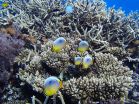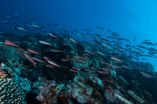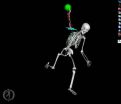For overfished coral reef systems, restoring fish populations that perform key roles will in turn restore ecological functions critical to recovery. For moderately or lightly fished reefs, the recipe requires knowing which fish to catch, how many, and which to leave behind.
The authors assessed fish biomass and functional groups from more than 800 coral reefs worldwide and used them to estimate recovery periods for both lightly fished and overfished reefs. The scientists speculate that maintaining and restoring fish populations and the functions they provide can increase the resilience of reefs to large-scale threats such as climate change.
The coral reefs of the world are in crisis, endangered by a number of coastal threats such as overfishing, pollution, and coastal development as well as global threats such as climate change. According to the World Resources Institute, some 75 percent of the world's coral reefs are now threatened and more than 20 percent have disappeared since climate and fishing disturbances have accelerated in the past 30 years. At the same time, only 27 percent of the world's coral reefs are contained within marine protected areas.
"By studying remote and marine protected areas, we were able to estimate how much fish there would be on coral reefs without fishing, as well as how long it should take newly protected areas to recover," said M. Aaron MacNeil, Senior Research Scientist for the Australian Institute of Marine Science and lead author on the study. "This is important because we can now gauge the impact reef fisheries have had historically and make informed management decisions that include time frames for recovery."
"The methods used to estimate reef health in this study are simple enough that most fishers and managers can take the weight and pulse of their reef and keep it in the healthy range," said Tim McClanahan, WCS Senior Conservationist and a co-author on the study. "Fishers and managers now have the ability to map out a plan for recovery of reef health that will give them the best chance to adapt to climate change."
Coral reef experts agree that fishing is a primary driver in the degradation of reef function, which in turn has generated growing interest in finding fisheries management solutions to support reef resilience. Removing too many herbivorous and predatory fish species deprives coral reefs of critical ecosystem functions and the capacity to respond effectively to other disturbances. Knowing the right amount to leave behind can help local fisheries set clear limits to how many fish can be taken without threatening the ecosystem they rely on.
In response to this need, the study authors have created the first empirical estimate of coral reef fisheries recovery potential using data from 832 coral reefs in 64 locations around the world. The analysis included marine reserves and fishing closures as a control for estimating healthy fish biomass along with numerous sites along a spectrum of fishing intensity, from heavily fished reefs in the Caribbean to locations with low fishing rates and high fish "biomass" such as the Easter Islands. Despite the breadth of the data, some simple and consistent numbers emerged from the study.
Some of the key metrics uncovered in the study:
According to the analysis, a coral reef with no fishing averages 1,000 kilograms per hectare of fish biomass. The fish biomass threshold for a collapsed reef--overfished to the point of nearly total ecosystem failure--is 100 kilograms per hectare. The most degraded reefs lack browsers (rudderfish, parrotfish, and surgeonfish), scraper/excavators (parrotfish), grazers (rabbitfish, damselfish), and planktivores (fusiliers), so the first steps in reef recovery depends on allowing these species and the services they provide to return. Coral reefs that maintained 500 kilograms of fish biomass per hectare (about 50 percent of an average reef's carrying capacity) were found to maintain ecological functions while sustaining local fisheries, providing fishers and marine managers with a critical target. The authors found that 83 percent of the 832 reefs surveyed contained less than the 500 kilogram fish biomass threshold needed to maintain ecological integrity and stave off decline. The models generated time estimates needed for both unregulated and partially regulated coral reef fisheries to recovery; a moderately fished coral reef system can recover within approximately 35 years on average, while the most depleted ecosystems may take as long as 59 years with adequate protection.
The study also highlights the benefits of alternative fisheries restrictions, including bans on specific fishing gear such as small-mesh nets and restrictions on herbivorous species. Approximately 64 percent of coral reefs with fishing regulations (including bans on specific fishing gear such as small-mesh nets and restrictions on fishing of herbivorous species) were found to maintain more than 50 percent of their potential fish biomass.
"Reef fish play a range of important roles in the functioning of coral reef ecosystems, for example by grazing algae and controlling coral-eating invertebrates, that help to maintain the ecosystem as a whole," said coauthor Nick Graham of James Cook University. "By linking fisheries to ecology, we can now make informed statements about ecosystem function at a given level of fish biomass."
"The finding that gear restrictions, species selection or local customs can also contribute to fish population recovery is compelling. It demonstrates that managers can use a range of different management strategies in areas where it may not be culturally feasible to establish permanent marine reserves," said coauthor Stacy Jupiter, WCS Melanesia Program Director. "Having a portfolio of management options provides flexibility to respond to local social and economic contexts. However, only completely closed no-take marine reserves successfully returned large predatory fish to the ecosystem."
INFORMATION:
YouTube video related to this story: https://www.youtube.com/watch?v=fDzMzyWZxL8&feature=youtu.be (Credit: WCS)
Fish are the key ingredients in a new recipe to diagnose and restore degraded coral reef ecosystems, according to scientists from the Australian Institute of Marine Science, WCS, James Cook University, and other organizations in a new study in the journal Nature.
This study was generously supported by the John D. and Catherine T. MacArthur Foundation, the Australian Institute of Marine Science, and the ARC Centre of Excellence for Coral Reef Studies.
The authors of the paper titled "Recovery potential of the world's coral reef fishes" are: M. Aaron MacNeil of the Australian Institute of Marine Science; Nicholas A.J. Graham and Joshua E. Cinner of James Cook University; Shaun K. Wilson of the Australian Department of Parks and Wildlife; Ivor D. Williams of the NOAA Pacific Islands Fisheries Science Center; Joseph Maina of the Wildlife Conservation Society and Newcastle University; Steven Newman of Newcastle University; Alan M. Friedlander of the University of Hawaii; Stacy Jupiter of the Wildlife Conservation Society; Nicholas V.C. Polunin of Newcastle University; and Tim R. McClanahan of the Wildlife Conservation Society.



